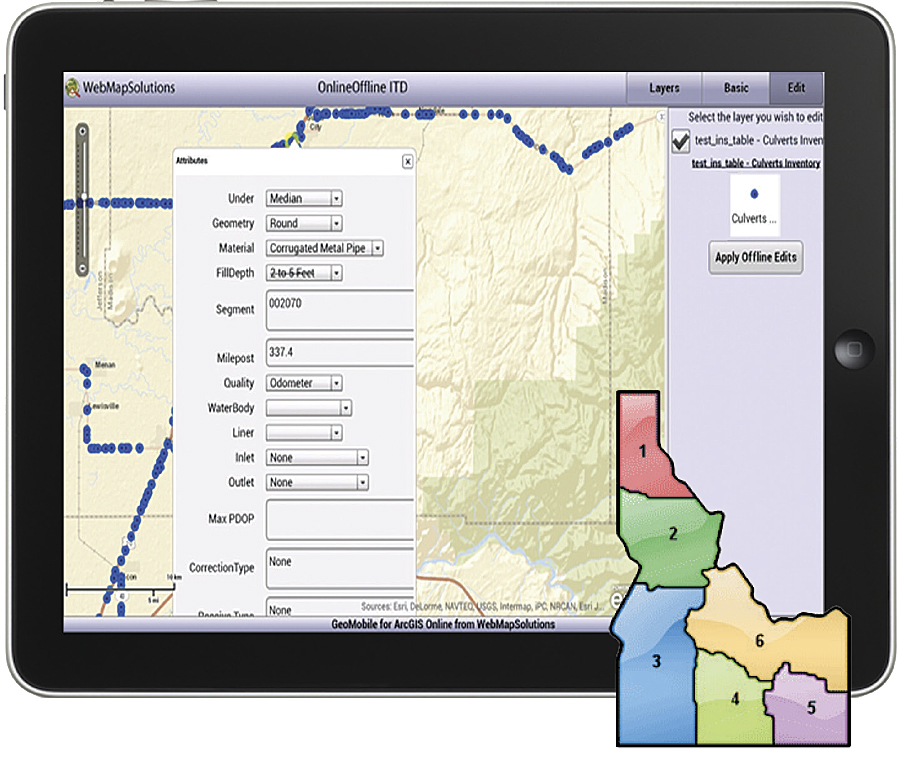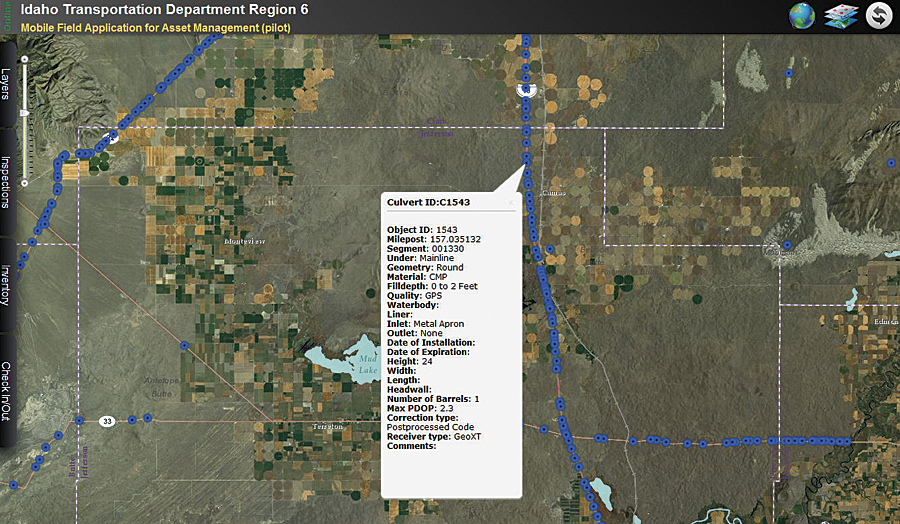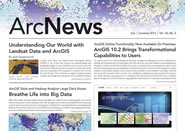Web-Based, Cross-Platform Mobile Application Is Just the Ticket
Once considered part of the American Wild West, today the state of Idaho is a large, sparsely inhabited state. It is a land of contrast, with spectacular mountains, deep gorges, and nine national forests covering two-fifths of the state. Most of the state’s population lives in the semiarid southern Snake River Plain, a land of rolling hills, in marked contrast to the rugged, mountainous central and extreme eastern parts of the state. Naturally, Idaho’s roads link all this diversity together.

The Idaho road network is administered by the Idaho Transportation Department (ITD). ITD has jurisdictional responsibility for almost 5,000 miles of highway and more than 1,700 bridges. The remoteness of much of this network is a key challenge to many of the ITD field crews. Hauling equipment for inspection and repair, over large distances, to uninhabited areas makes the work both difficult to do and coordinate. Often, cell phone access is not possible.
ITD is organized into six districts. ITD District 6 covers the northeastern portion of the state. In 2012, Bill Shaw, a project engineer and manager of the Planning and Public Involvement Section in ITD District 6, turned his attention to overcoming some of the challenges faced by ITD. The purpose was essentially twofold. First, streamline by moving away from the paper-based system used by field crews and reducing the number of data silos within the district. Second, install a mapping system to better coordinate field-workers and share information within the agency and with the public. ArcGIS Online was to be the technology at the center, given its potential to provide a unified solution. The goal was to build a mobile application targeted at field crews, which leveraged ArcGIS Online and helped demonstrate the capabilities of this new platform to ITD District 6 and the wider organization.
Project Planning
ITD District 6, under Shaw’s guidance, was looking to work with a US-based company with ArcGIS Online expertise, which specialized in the development of mobile applications. He narrowed the field down to WebMapSolutions, a GIS software company and Esri Partner based in Salt Lake City, Utah, specializing in the development of both web and mobile GIS applications. Much of the company’s focus is now on ArcGIS Online. Given this in-depth knowledge of ArcGIS Online and mobile development, ITD District 6 commissioned WebMapSolutions to help with this investigation. The work was funded by the US federal government and closely supported by Esri under the American Association of State Highway & Transportation Officials Technology Implementation Group UPlan initiative. The mobile application planned was to provide data collection and editing capabilities to field crews. So inspections of ITD assets, such as culverts, would be done using a tablet-based mapping application instead of pen and paper. Feature attributes could be updated, new features added, and images attached to individual features and then uploaded to ArcGIS Online directly from the mobile device. Given the lack of Wi-Fi access in much of the state, a key requirement of the mobile app was for it to function in both connected and disconnected modes.

Mobile Data Editing App Project Phases
WebMapSolutions took a two-phase approach to the development of the mobile editing application. In the first phase, a technical investigation was undertaken, the planned end result being a working prototype. The second phase targeted a production release.
Mobile technology continues to evolve. There are two “flavors” of mobile apps: those accessed via a web browser and those that are installed and can be downloaded from the Apple and Android mobile app stores. In phase 1 of the project, it was decided to develop a web-based, mobile, cross-platform application built in HTML5.
Phase 1 was successfully completed at the end of 2012. Since the data had originally been published in ArcGIS for Server, it was decided to simply optimize the data and remain focused on mobile development. ArcGIS Online was to be part of the second phase. Many technical questions were answered in this first phase and application workflows and design put in place. This work and what was learned would help guide the next phase.
Work began on phase 2 of the project in January 2013. Phase 2 specifications included the following:
- Publishing and accessing data through ArcGIS Online
- Greater focus on the data, most notably the application of the Transportation Data Model
- The ability to use the mobile app in disconnected or offline mode
ArcGIS Online was an important addition to this second phase of the work. The use of this new platform offers both short- and long-term benefits. From a development perspective, the mapping platform simplifies the code required. ITD District 6 staff can now publish web maps without the need of specialized GIS knowledge.
Given the new requirements, most notably offline data access and editing, it was decided to develop an installed application in place of a web app. Adobe’s Flex was used in place of HTML5.

Online/Offline Mobile App Development
The mobile application was designed to be intuitive. In areas of poor or no Wi-Fi service, users have the option to switch to offline mode. When offline, the data used by the app is local, or stored on the mobile device. Features can be added, edited, or deleted. Feature attachments—images, audio, and video—can also be included. When back in Wi-Fi range, users can upload the changes to the mapping platform.
An important finding in the first phase was performance degradation when more than 1,500 editable features were visible. Both map panning and zooming were slow with a large feature count. ITD District 6 is subdivided into field office areas. Since field crews operate from these offices, servicing these areas, it was decided to publish web maps for each field office area. Crews operating from each field office loaded their own web maps in the mobile app. This eliminated potential performance issues and provided field crews with targeted, task-specific data.
The mobile app was designed to be highly configurable. It relies on a configuration file, which allows administrators to not only control the web map consumed by the app but also the look and feel of the interface (logo, title, and color).
Looking Ahead
Phase 2 of this development effort was ongoing during the first quarter of 2013. Providing new tools to ITD District 6 field crews is the immediate goal. ArcGIS Online, as a mapping platform, helped overcome the organizational and data access challenges currently faced by ITD District 6 and other ITD districts.
For more information, contact Bill Shaw, project engineer and manager of the Planning and Public Involvement Section in ITD District 6, or Matt Sheehan, principal at WebMapSolutions.

